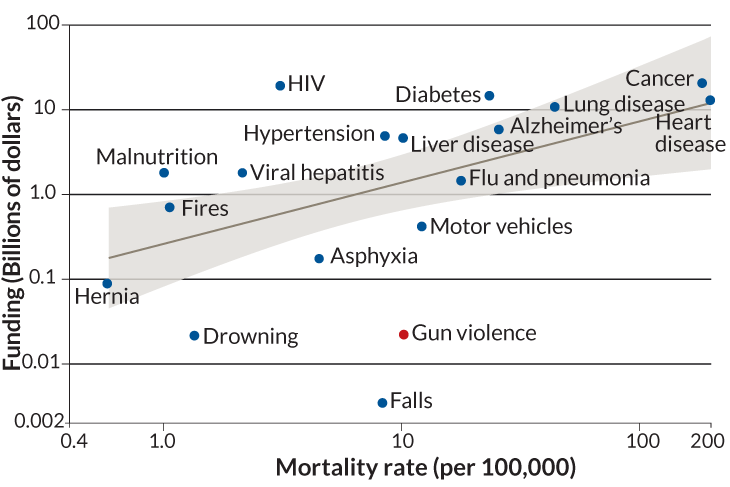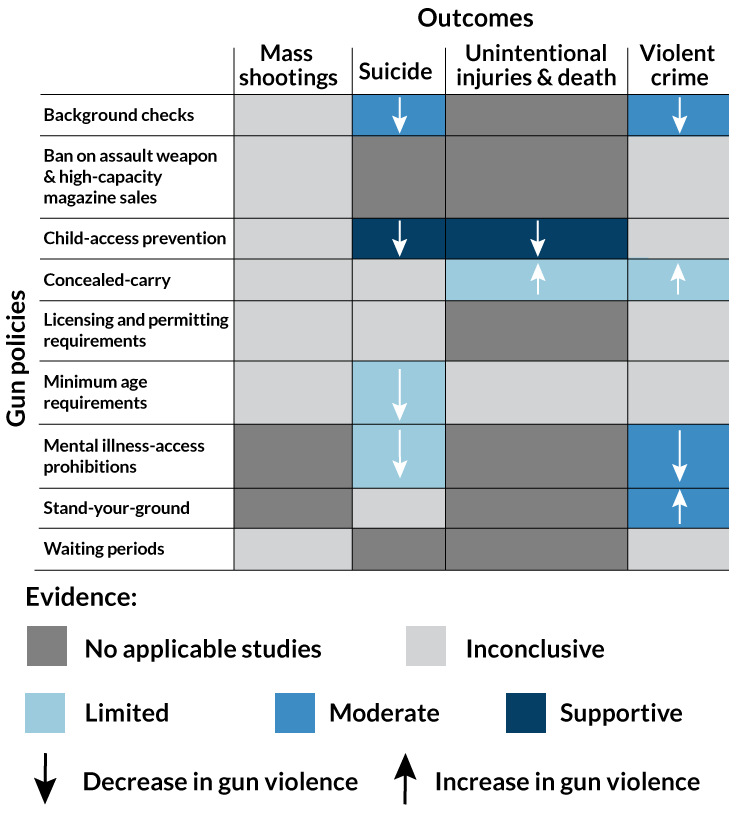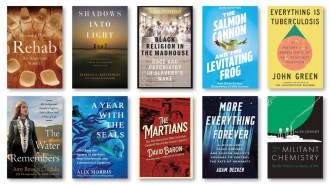What we do and don’t know about how to prevent gun violence
Lack of research makes it hard to determine laws’ effect on saving lives

JUMP THE GUN Arguments about which gun laws might reduce gun violence are hard to settle, given how little research there is on gun policy effectiveness, but a new study has some answers.
PopTika/Shutterstock
- More than 2 years ago
In the fraught days following a mass shooting, people often ask if an assault weapons ban or allowing concealed carry permits would reduce the likelihood of further violence. But reliable evidence on the effects of those policies can be hard to find.
Now the largest comprehensive analysis of research on U.S. gun policy in years offers some answers, but also troublingly little guidance. A glaring finding of the study, published by the RAND Corporation March 2, is how little work has been done to know which policies work.
“The research literature on gun policies is really very thin,” says Andrew Morral, a behavioral scientist at RAND, a nonpartisan institute based in Santa Monica, Calif.
Ideally, solid research leads to effective public health policies, which then reduce deaths, be it from guns, car accidents or fires. But when it comes to gun research, good science is lacking, says Morral, who led the study. So legislators typically turn to experts and advocates who can disagree vehemently about the effects of laws.
The goal of the report is to help people understand “what is reasonably well-known and what isn’t,” says Morral. “Hopefully we can work from there and identify where research can be most helpful.”
Gun shy
Compared with other leading causes of death, research into gun violence is among the least funded, an analysis of U.S. mortality data and federal funding from 2004 to 2015 reveals. Funding for research on gun violence is 1.6 percent of what would be expected, given the number of gun deaths.

Source: D.E. Stark and N.H. Shah/JAMA 2017
Morral and his colleagues reviewed existing research on 13 types of gun policies, including concealed carry laws and waiting periods, and their impact on health, and safety, including mass shootings, suicides and accidental deaths. Next the researchers looked to see if those studies were any good. Out of thousands of studies considered for the analysis, a mere 63 met the research team’s strict criteria: Studies had to use rigorous methods and establish cause and effect.
The team ranked the strength of the evidence of a given policy’s effectiveness as limited (at least one study showed an effect, which wasn’t contradicted by other studies), moderate (two or more studies showed the same effect, no contradictory studies) or supported (three or more studies with at least two independent datasets found an effect with no contradictory studies). Here are the biggest takeaways:
1. There’s not enough data to show what would prevent mass shootings. There is no universal definition of a mass shooting, which, along with their relative rarity, makes it hard it hard to spot trends, such as whether mass shootings are on the rise. Studies looking at seven of the investigated policies, including concealed carry laws and background checks, were inconclusive about whether those policies lowered the likelihood of a mass shooting. For nearly half the gun policies, including gun-free zones, prohibitions associated with mental illness and stand-your-ground laws, no studies met the researchers’ criteria.
2. Keeping guns out of the hands of kids is good policy. There’s solid evidence that these laws reduce unintentional firearm injuries and deaths among children. There’s some evidence these laws also reduce adult unintentional firearm injuries and deaths.
3. Gun policies can decrease the number of suicides. This is no small thing: Of the more than 36,000 U.S. gun deaths each year, two-thirds are suicides. Laws that prevent kids from getting access to guns reduce the number of suicides by young people. And there’s some limited evidence that keeping guns away from people with certain mental illnesses, minimum-age requirements and background checks all prevent suicides.
4. Background checks can work. Designed to prevent certain people, such as convicted felons or those subject to a restraining order, from buying guns, background checks do reduce some gun violence. There’s moderate evidence that these laws can reduce the number of firearm homicides and suicides and limited evidence that background checks reduce violent crime and homicides in general.
5. Keeping guns out of the hands of the mentally ill has mixed effects. While there’s limited evidence that these laws can reduce the number of suicides, there’s slightly stronger proof that these laws reduce the amount of violent crime in general.
6. Allowing people to carry concealed guns ups gun violence. There’s limited evidence that laws that guarantee a right to carry increase unintentional firearm injuries among adults and increase violent crime.
7. Saying it’s OK to “stand your ground” can also lead to gun violence. Rather than curtailing gun deaths, there’s moderate evidence that laws that let people claim self-defense even if they don’t ty to retreat from a perceived threat lead to an uptick in homicide rates. There were no studies that met the researchers’ strict criteria demonstrating that stand-your-ground laws lower the likelihood of any gun-related violence.
Few smoking guns
Some gun policies, such as background checks, do curtail gun violence (down arrows), while others, like concealed carry laws, lead to an uptick (up arrows). But for most policies, the data are inconclusive or lacking entirely (light and dark gray).
Effects of gun laws

Source: A.R. Morral et al/RAND Corporation 2018
The analysts found little or no research on the impact of other policies, including gun-free zones, firearm sales reporting requirements and bans on assault weapons.
Many scientists, including the authors of the RAND report, blame federal directives that, for the past two decades, have forbidden the Centers for Disease Control and Prevention from “advocating or promoting gun control” and slashed its funding.
“That sent a very loud signal that firearms research was dangerous to your budget,” Morral says.
Similar language was added to the funding bill for the National Institutes of Health in 2012 and the end result is today the U.S. government invests very little in research on firearms and public health (SN: 5/14/16, p. 16). A recent JAMA study comparing spending on leading causes of mortality, such as cancer, malnutrition and hypertension, found that gun violence research funding was only 1.6 percent of what would be expected, given the number of people that die from guns each year. The same analysis looked at the volume of scientific papers published for each cause of death and, relative to mortality rates, guns were the least researched.
Good data are needed for good policy, says David Hemenway, an expert on injury and violence prevention at Harvard T.H. Chan School of Public Health. To understand, for example, whether collapsible steering columns in cars prevent driver deaths, it takes data on head-on collisions, says Hemenway, not just motor vehicle deaths in general. Such fine-grained data are lacking for much of gun-related violence.
Those data likely will reveal that there’s no one-size-fits-all policy to reduce gun-related violence, says Hemenway. Interventions that reduce gun violence in at-risk communities might be very different than, say, policies for reducing mass shootings. But without the research, it’s hard to know. Hemenway is confident that over time, data and science will win out. “Every success in public health meets with opposition,” he says. “You have to fight and fight and it takes much longer than you hope.”







